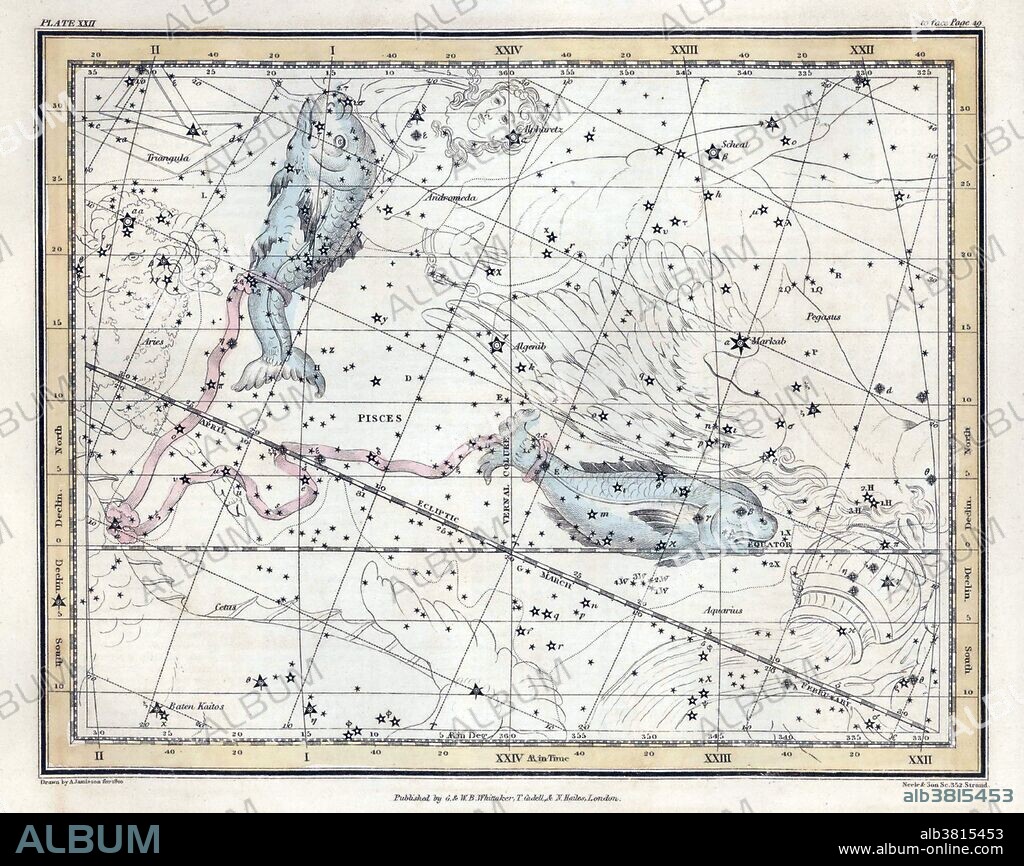alb3815453
Pisces Constellation, Zodiac, 1822

|
Add to another lightbox |
|
Add to another lightbox |



Buy this image.
Select the use:

Title:
Pisces Constellation, Zodiac, 1822
Caption:
Pisces is a constellation of the zodiac. Its name is the Latin plural for fish. It is one of the 48 constellations described by the 2nd century astronomer Ptolemy, and remains one of the 88 modern constellations defined by the International Astronomical Union. It lies between Aquarius to the west and Aries to the east. The ecliptic and the celestial equator intersect within this constellation and in Virgo. Pisces is the twelfth astrological sign in the Zodiac, originating from the Pisces constellation. It spans the 330-360th degree of the zodiac, between 332.75 and 360 degree of celestial longitude, which in the Tropical zodiac the Sun transits this area on average between February 19 to March 20 each year. A Celestial Atlas (1822) by Alexander Jamieson, inspired by the star atlas of Johann Elert Bode, but restricted itself to stars that could be seen with the naked eye. Comprising a systematic display of the heavens in a series of thirty maps illustrated by scientific description of their contents and accompanied by catalogues of the stars and astronomical exercises, plate 22, 1822.
Credit:
Album / Science Source / U.S. Naval Observatory Library
Releases:
Model: No - Property: No
Rights questions?
Rights questions?
Image size:
3600 x 2859 px | 29.4 MB
Print size:
30.5 x 24.2 cm | 12.0 x 9.5 in (300 dpi)
Keywords:
1822 • 19TH CENTURY • ALEXANDER JAMIESON • ART • ARTWORK • ASTERISM • ASTROLOGIA • ASTROLOGICAL • ASTROLOGY • ASTRONOMIA • ASTRONOMICAL • ASTRONOMY • CELEBRITIES • CELEBRITY • CELESTIAL ATLAS • CELESTIAL BODY • CELESTIAL SPHERE • CELESTIAL • CONSTELLATION • DRAWING • ENGRAVING • FAMOUS PEOPLE • FAMOUS • FISH, THE • HEAVENLY BODY • HEAVENLY • HISTORIC • HISTORICAL • HISTORY • HOROSCOPE • ILLUSTRATION • ILLUSTRATIONS • IMPORTANT • JAMIESON • NOTABLE • OCCULT • PATTERN OF STARS • PISCES • PISCES, ZODIAC • SCIENCE • SIGNS OF THE ZODIAC • SIGNS • STAR ATLAS • STAR CHART • STAR MAP • WELL-KNOWN • ZODIAC • ZODIAC: PISCES • ZODIACAL
 Pinterest
Pinterest Twitter
Twitter Facebook
Facebook Copy link
Copy link Email
Email
